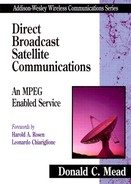Chapter Two Regulatory Framework
This chapter explains where a number of the fixed attributes of DBS come from, including uplink frequencies, downlink frequencies, polarization, and orbital positions. The rest of this book discusses what has been done to maximize the services that can be provided by DBS.
The orbital locations, spectrum, and other parameters were established by international agreement. The Federal Communications Commission (FCC) then granted licenses to companies for transponders at the orbital locations granted to the United States by the international agreements.
The original licensees received the transponder licenses at no cost (other than legal fees). The most recent reallocation of these transponders was done by auction. The results are described in section 2.3.
2.1 The 1977 World Administrative Radio Council and 1983 Regional Administrative Radio Council
In 1977, a World Administrative Radio Council (WARC) made the farsighted decision to allocate spectrum and set parameters for a DBS service also called Broadcast Satellite Service (BSS). The 1977 WARC made the allocations for region 1 (Europe) and region 3 (Asia and Oceana), and made a preliminary plan for region 2, the Western Hemisphere [WARC77].
One of the critical decisions was that the orbital spacing for clusters of satellites would be 9 degrees. This has far-reaching implications for overall DBS capacity.
In 1983, a Regional Administrative Radio Council (RARC) made the comparable decision for region 2, which includes the United States and the rest of the Western Hemisphere. Eight orbital positions were set aside for the United States. The spectrum was established as 17.3-17.8 GHz for the uplink and 12.2-12.7 GHz for the downlink. Thirty-two frequencies were allocated at each orbital slot [RARC83].
The RARC also made a provision for frequency reuse. Figure 2.1 shows the complete frequency plan. As can be seen, there are 16 transponders with right-hand circular polarization and 16 transponders with left-hand circular polarization. This permits 32 24-MHz bandwidth transponders in the 500-MHz DBS band with 5-MHz spacing between transponders. The Effective Isotropic Radiated Power (EIRP) was established as 57 dBW.
Figure 2.1 Region 2 DBS Frequency Plan

Source: Adapted from Proceedings published by the Regional Administrative Radio Council in 1983.
2.2 Federal Communications Commission Licensing
The following orbital locations are the ones allocated to the United States for which the FCC granted licenses for transponders: 61.5° West, 101° West, 110° West, 119° West, 148° West, 157° West, 166° West, and 175° West.
Initially, the first four orbital locations in this list were called the Eastern locations and the last four were called the Western locations, because it was believed the satellites would not be powerful enough to cover the entire Continental United States (CONUS). However, DIRECTV™ and United States Satellite Broadcasting (USSB) proved that satellites could be powerful enough to cover CONUS. Subsequently, the orbital locations at 101°, 110°, and 119° W longitude were called ‘full CONUS’ and the others ‘partial CONUS.’
Note that the orbital location at 61.5° W longitude was designated full CONUS at one time because it is possible for U.S. West Coast-based receivers to see a Geostationary Earth Orbit (GEO) at 61.5° W longitude. The elevation angles are so small, however, that a high percentage of locations are blocked by trees, buildings, hills, and so forth. So the FCC relented and agreed to call the 61.5° W longitude slot a partial CONUS.
2.3 Recovery and Reallocation of Spectrum
Advanced Communications Corporation (ACC) received one of the conditional construction permits issued in 1984 for 27 full-CONUS transponders at 110° W longitude and 24 partial-CONUS transponders at 148° W longitude.
In the fall of 1995 the FCC determined that ACC had not exercised due diligence in moving towards a DBS system and reclaimed all 51 transponders. The FCC then decided that the most equitable way to distribute these transponders was by auction.
It also should be noted that the FCC never allocated one of the transponders at 110° W longitude. The FCC added this transponder to the 27 recovered from ACC to create a package for the auction.
The 28 full-CONUS transponders at 110° W were auctioned off in the first quarter of 1996. The winning bid was an astounding $682 million dollars by MCI. Ironically, during the FCC’s preparation for the auction, one of the FCC commissioners warned his colleagues not to be swayed by the fact that one of the prospective bidders was prepared to bid the unbelievable sum of $175 million. The winning bid was almost four times this.
EchoStar subsequently won an auction for the 24 transponders at 148° W longitude partial-CONUS orbital slots.
Figure 2.2 and Table 2.1 show the licensees at each of the U.S. orbital locations and the percentage of DBS transponder ownership by these licensees.
Figure 2.2 Current Allocations of U.S. DBS Channels
Source: From the Consumer Project on Technology, Center for the Study of Responsive Law, Washington, DC, March 15, 1996 (see also http://www.essential.org/cpt/telecom/echo.txt).
Table 2.1 U.S. DBS Channel Ownership

References
[FCC95a] FCC Notice of Proposed Rulemaking, ‘In the Matter of Revision of Rules and Policies for the Direct Broadcast Satellite Service’ (FCC 95-443), October 27, 1995.
[FCC95b] FCC Report and Order, ‘In the Matter of Revision of Rules and Policies for the Direct Broadcast Satellite Service’ (FCC 95-507), December 15, 1995.
[IPN96] Information Policy Note, from an Internet newsletter (available from [email protected]), April 2, 1996.
[RARC83] RARC, Proceedings of the 1983 Regional Administrative Radio Council, Geneva, Switzerland.
[WARC77] WARC, Proceedings of the 1977 World Administrative Radio Council, Geneva, Switzerland.

